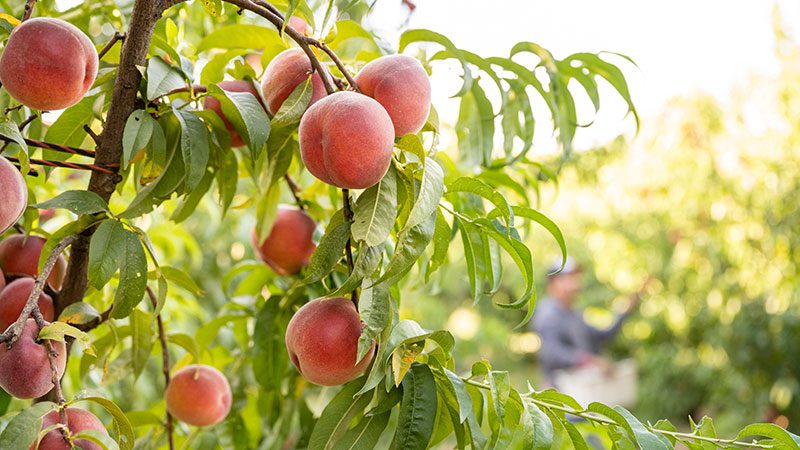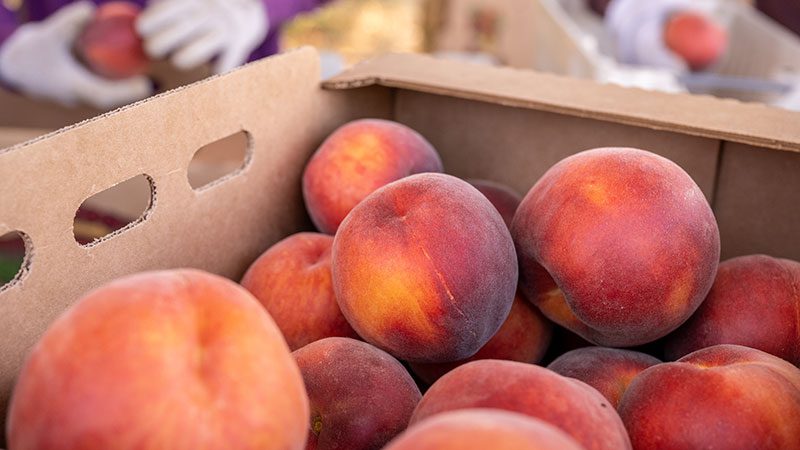Peak peach season: Eating and cooking with LaPierre peaches
By Tara Austen Weaver, guest contributor

Photo by Shawn Linehan
It’s summer, and peaches are high on the list of peak seasonal experiences —that annual delight of biting into a piece of fruit so luscious the juice runs down your arm until it drips, in sweet syrupy droplets, off the end of your elbow. Ripe local peaches are a pleasure we wait all year to enjoy.
When it comes to PCC, those peak peach moments start in the Rattlesnake Hills of the Yakima Valley, where the LaPierre family has been growing fruit since 1985. Mark LaPierre comes from farming heritage—grandparents on both sides were farmers—and after earning a horticultural degree from Washington State University he bought a small piece of land near Zillah, WA, and planted a cherry orchard not far from where his grandfather had once grown table grapes.
Spotlight on local peaches
Over the years the LaPierres—Mark and Marni—expanded their land and their crops to include peaches, blueberries nectarines, apples and more. They eventually expanded the business to include daughter Lauren and son Garret. One of the earliest organic growers in the state, the family prioritizes organic farming methods and sustainability on all fronts—even introducing a fully compostable bag for their cherries in 2022.
PCC suppliers for more than 35 years, the LaPierres now have 10 acres in peaches and, assisted by a harvest crew of 60, bring in more than a million pounds of fruit a year. They grow a cultivar called Sierra Rich, selected for its bold flavor and minimal fuzz. “It’s a great peach for cooking, baking, canning—or just eating fresh,” explains Lauren LaPierre. The organic peaches, a The Talk of The Co-op pick for August, are delivered seven days a week to PCC stores.
The LaPierres continue to expand—adding wine grapes to their farm in 2018, and opening up a tasting room in 2023 for their all-organic red wines and seasonal rosé. But they haven’t strayed far from their roots. The tasting room features views of Mt. Rainier and Mt. Adams—as well as a fruit market in season.

when is peach season
Peach season in the Northwest typically runs from July through September. (This handy calendar covers growing seasons for all types of local fruits and vegetables.) While Washington isn’t the first state people think of for peaches, it’s a sizable producer, ranking around 7th in the nation for peach production. (Georgia is the state most people associate with peaches, though California is the nation’s top producer by a peachy mile, followed by South Carolina.)
Three unique peach recipes
Watch for the LaPierre Farms sign by peaches at PCC stores — they’re the co-op’s exclusive peach supplier so long as the farm’s crop is in season. LaPierre Farms also supplies PCC with blueberries (fresh and frozen), red and Rainier cherries, nectarines, apriums and Honeycrisp apples.
While we always love a peak juicy peach eaten out of hand, here are a few other favorite ways to enjoy and preserve one of summer’s most luscious fruits. Check out PCC’s peach recipes here, including peach or nectarine crisp, peach-raspberry pops and more, or enjoy the following recipes for crumble bars, salsa and jam.
Peach and Raspberry Crumble Bars
Crumble bars have some of the same allure as peach pie, but they are infinitely easier to transport to your favorite picnic location or pool party. Here raspberries make a tangy addition to buttery peaches, but you can swap them out for blackberries, blueberries, or make an all-peach version as well, if you like.
1½ cup granulated sugar, divided
1 teaspoon baking powder
3 cups all-purpose flour
½ teaspoon salt
1 cup (two sticks) cold unsalted butter, cut into pieces
1 large egg
½ teaspoon vanilla
1 tablespoon cornstarch
1 teaspoon lemon zest
3 cups sliced peaches, not peeled (okay to use frozen, but do not let them thaw)
1 cup raspberries
Preheat the oven to 375 degrees F and butter a 9 × 13-inch pan.
In a medium mixing bowl, stir together one cup of the sugar, all the flour, baking powder, and salt. Use a pastry cutter, fork, or your fingers, mix in the butter, egg, and vanilla. Add half of the dough to the prepared baking pan and press down with your hand to make a solid bottom crust.
In another medium bowl, stir together the remaining ½ cup sugar, cornstarch, and lemon zest. Gently mix in the peaches and raspberries, coating each piece of fruit before spreading evenly on top of the crust. Crumble the remaining dough over the fruit.
Bake for about 45 mins, or until the top is slightly brown and the fruit has begun to bubble. Let cool in the pan completely before cutting into pieces. Keep in the fridge for up to two days, or freeze for longer storage.
Peach Avocado Salsa
Peaches shine in this tangy fresh salsa, good on grilled fish or scooped up with chips.
1 avocado, cubed
2 medium peaches (about 1½ cups), cubed
3 tablespoons finely minced red onion
1 radish, finely minced
1 jalapeño pepper, seeded and diced (can be omitted for a milder salsa)
2 tablespoons cilantro, finely chopped
Juice of one lime
Salt and freshly ground black pepper to taste
Add all ingredients to a small bowl and gently turn with a spoon to mix. Make just prior to serving.
Peach Jam
For the peach lover who wants to enjoy the flavor all year long. Makes four to five 8-oz jars.
2 ½ lbs. peaches, pitted and chopped (about 6 cups)
1 lb. granulated white sugar
3 tablespoons freshly squeezed lemon juice
In a large bowl, mix the fruit, sugar, and lemon juice until fully combined. Let the mixture sit for at least two hours before proceeding with the recipe.
Place a small saucer in the refrigerator. This will be used later.
Pour the mixture into a large, non-reactive pot—the widest you have available. Set the pot over a medium-high heat and bring to a boil. Reduce the heat to a simmer and cook, stirring occasionally, for about 30 minutes.
As the jam cooks, skim off any foam that rises to the top with a spoon or mesh skimmer (this can be mixed into yogurt or eaten plain).
Once the fruit has broken down, test the jam by spooning a small amount into the chilled saucer from the refrigerator. Return the saucer to the refrigerator for a few minutes to cool. All jam is liquid at high heat, so it’s important to adequately chill your sample.
If the cooled mixture runs when you tilt it to the side, continue to simmer it for a bit longer and test again.
The sugar required to preserve fruit can easily burn in the final stages of jam making, so make sure to pay close attention. When the saucer is tilted and a spoon drawn through the middle of the cooled sample leaves an open line, the jam is thick enough. Remove the pot from the heat.
To preserve for shelf-stable storage, ladle the warm jam into sterilized canning jars and process according to safe canning practices (the USDA guide to home canning can be found at www.healthycanning.com). Alternately, freeze and use within six months, thawing fully before serving.
Tara Austen Weaver is a writer, editor, and author of seven books, including Growing Berries and Fruit Trees in the Pacific Northwest and the Little Book of Flowers series: Peonies, Dahlias, and Tulips.
